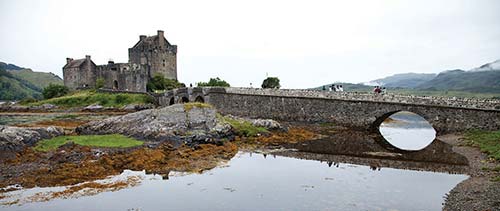
PREHISTORIC ORIGINS, ROMAN REBELLION, AND HIGHLAND CLANS
WILLIAM WALLACE, ROBERT THE BRUCE, AND MEDIEVAL INDEPENDENCE
MARY, QUEEN OF SCOTS; JOHN KNOX; AND THE PROTESTANT REFORMATION
KING JAMES VI/I, KING CHARLES I, AND CIVIL WAR
ENGLAND’S ASCENDANCY AND THE ACT OF UNION
JACOBITE RISINGS AND MASS EMIGRATIONS
SCOTLAND REBOUNDS: SCOTTISH ENLIGHTENMENT, INDUSTRIAL REVOLUTION, AND HIGHLAND REVIVAL
THE 20TH CENTURY: SCOTLAND AT WAR
SCOTLAND TODAY: DEVOLUTION AND SCOTTISH PRIDE
Rugged and remote, Scotland has had a particularly hard-fought history. Split by the Highland Boundary Fault, which separates the flatter, more Anglo-Saxon, more London-looking Lowlands in the south from the craggy, deeply Celtic Highlands in the north, the two halves have distinct characters. Ringing the country are distant islands—the Hebrides, Orkney, and Shetland—each bringing its own local customs, history, and traditions to the table. Since ancient times, the feisty people of Scotland—Highlanders and Lowlanders alike—have fought to preserve their region’s unique identity. Scotland’s rabble-rousing national motto is Nemo me impune lacessit—“No one provokes me with impunity.” In Scotland, perhaps more than most places, legends of national heroes abound.
Scotland’s first inhabitants were hunter-gatherers who came north as the Ice Age receded (7000 B.C.). In Neolithic times (4500-2000 B.C.), a new wave of farmer-herders arrived from the south. They left us stone circles and passage graves (funeral mounds with a burial chamber inside, reached by a passage). While few Neolithic structures survive in Scotland, Orkney—which flourished during this age—has some of the UK’s best and oldest (see here).
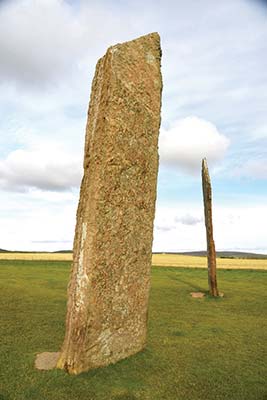
Also during the Stone Age, people began to settle on the waters of Scotland’s many lochs, building igloo-shaped fortified islands called crannogs. Made of wood and built upon timber pilings driven deep into the loch’s floor, they were linked to the shore only by a removable wooden plank. Crannogs were at once well-protected and easy to access (in an age when most travel was by boat), and they provided unobstructed views across the loch. Many circular “islands” you may notice in lochs today are likely grown-over, abandoned crannogs. (For more on crannogs, visit the excellent Crannog Centre on Loch Tay—see here.)
Around 500 B.C., the Celts moved in from Europe, bringing Iron-Age technology and the language that would develop into the Gaelic tongue. The Celts built hilltop forts, with large stone towers called brochs.

In A.D. 80, Roman legions—having already conquered England—marched north and established a camp near Edinburgh. They called today’s Scotland “Caledonia” (a term you’ll still see everywhere) and battled the fierce Celts, whom they dubbed Caledonii—or “Picts” (“painted”; for their war paint). But the Picts would not surrender. Eventually, the Romans decided they had expanded far enough—and Scotland just wasn’t worth the effort. It was mountainous, wild, and dangerous—not just with Picts, but with predatory beasts such as bears, wolves, and lynx. The Romans sealed off Caledonia (and the pesky Picts) with two walls—the famous Hadrian’s Wall (73 miles long and up to 20 feet high), running more or less along the modern-day border between Scotland and England, and the lesser-known Antonine Wall (from the Firth of Clyde to the Firth of Forth—essentially from today’s Glasgow to Edinburgh). From then on, while England was forever stamped with a Roman/European perspective, Scotland was set on a course that was isolated and Celtic.
Medieval Scotland was a stew of peoples: Picts in the northern Highlands, Anglo-Saxons (Germanic invaders) in the south, and the “Scoti” (Celtic cousins from Ireland) on the west coast. (While little survives from this time, you can still see faint remains of some of the Scoti’s important sites in Kilmartin Glen—see here.) The Scoti gradually overwhelmed and absorbed the Picts. In their kingdom of Alba (the Gaelic name for Scotland), they established Gaelic as the chief language and Christianity—brought from Ireland by St. Columba in the sixth century—as the dominant religion. Even at this early date, Scotland’s geographical/ethnic boundary was already set: Gaelic/Celtic culture in the Highland north, English-friendly Anglo-Saxons in the Lowland south.
Vikings attacked from the north, and succeeded in capturing the northern islands, which remained Norse until the 15th century. (To this day, Orkney and Shetland have a Norwegian flavor and a heritage of Old Norse rune carvings and place names.) But much of the Scottish realm united under a Gaelic warlord named Kenneth MacAlpin. In 843, in his capital at Scone (50 miles north of Edinburgh), MacAlpin was crowned atop the Stone of Scone—making him the first king of Scots.
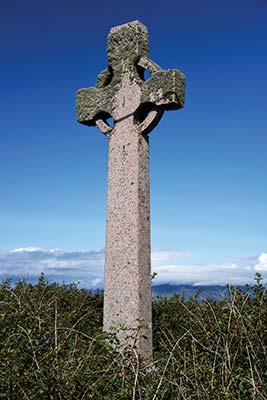
But this “Scotland” was a tiny and troubled land. In the 11th century (as Shakespeare later recalled it), King Duncan was murdered by one of his own men: Macbeth. King Macbeth was, in turn, killed by Duncan’s son, Malcolm Canmore—the man who would establish Edinburgh and bring remote Scotland onto the stage of the wider world.
Meanwhile, in the remote reaches of the Highlands and the Hebrides, communities were based on the clan system: tribes of people sharing a stretch of land managed by a chieftain, who served as a kind of caretaker for the people and future generations. In Gaelic, clann means “children”; the clan system was the traditional Scottish way of passing along power—similar to England’s dukes, barons, and counts. Although clan members took the chief’s name in solidarity, they were not necessarily related by blood. The patrilineal clan system eventually became further subdivided into septs—alliances of families who pledged allegiance to the same chieftain.
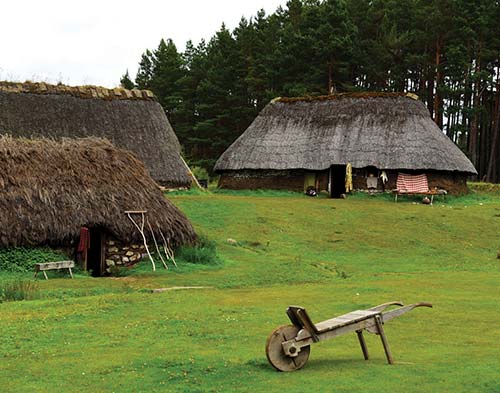
Most Highlanders were crofters (small, self-subsistence farmers) who lived in humble huts with dirt floors, dry-stone walls, and peat fires with heavy smoke that escaped through thatched roofs. (For a glimpse of this lifestyle—which persisted well into the 18th century—visit the Highland Folk Museum south of Inverness, described on here, or the Museum of Island Life on the Isle of Skye.) While it’s not quite true that each clan had its own carefully designed tartan pattern, clan members did tend to live in a single geographical area, where certain natural dyes and weavers predominated—so they likely dressed in (somewhat) similar colors. (For more on the kilt tradition, see here.)
Some clans were allies, either through intermarriage or through shared interests. Others were sworn enemies. One of the most famous rivalries was a three-way struggle between Clan Donald (or MacDonald), Clan Mackenzie, and Clan MacLeod, who clashed in several epic battles (see sidebar on here).
When King Malcolm III married the English Princess Margaret in 1070, it united the culture of the Highland Scots with that of the Lowland Anglo-Saxons. Margaret was exceptionally pious, and she fostered the Christian faith as never before. Increasingly, Scotland became ruled from the southern Lowlands and influenced by its southern neighbor, England. As English settlers moved north, they built castles and abbeys. They also brought with them a new social order—a hierarchical government that went beyond the small social unit of the Highland clan.
But in the far reaches of Scotland, the clan system still flourished. Clan Donald, based on the Isle of Skye’s Sleat Peninsula, controlled its own sprawling kingdom: In the 12th century, a great warrior named Somerled took control of the Lordship of the Isles, which included most of Scotland’s west-coast islands, and penetrated deep into the Highlands and present-day Northern Ireland (Antrim). This fully independent maritime state lasted until 1493, when its territory was finally folded into the holdings of the Stuart kings. (To this day, the British heir apparent carries the title “Lord of the Isles.”)
In 1286, the king of Scotland died without an heir. To settle the battle over succession, the Scots invited King Edward I of England (“Longshanks”) to arbitrate. Edward seized the moment to assert his power over Scotland. He invaded, defeated the chosen successor, and stole the revered coronation stone—the Stone of Scone—taking it back to London (where it remained, almost untouched, until 1996).
Enraged, the Scots rallied around nobleman William Wallace (see here). He defeated the English at Stirling Bridge (1297) and was named the “guardian of Scotland.” Wallace marched his army into England, plundered its north, then returned to Scotland—where he was defeated at the Battle of Falkirk in 1298. Disgraced, Wallace retreated to the Highlands and waged guerrilla warfare against the English until he was finally betrayed, arrested, and brutally executed in 1305.
The torch was passed to the earl of Carrick, Robert the Bruce (see here), who united Scotland’s many clans and defeated the English at the tide-turning Battle of Bannockburn (1314). Bruce was crowned King Robert, and his heirs would rule Scotland for the next four centuries under the Stewart family name. (Later, when Mary, Queen of Scots moved to France, she changed the spelling to “Stuart” because the French alphabet of the time lacked the letter “w”—for simplicity, I’ve used that spelling throughout this book.) Scotland had secured its independence.

Over the next two centuries, Scotland’s kings ruled from their castle in Stirling, gradually asserting central control over local clans and expanding the country’s boundaries into the modern nation. But the Stuart monarchy was still weak, beleaguered with infighting over succession. Fortunately, England was kept at bay, plagued by its own troubles fighting the French (Hundred Years’ War) and each other (Wars of the Roses). Scotland’s long-standing “Auld Alliance” with the French existed mainly to support its independence from England.
Everything changed when Henry VIII became king of England, sparking a border war with Scotland. In the Battle of Flodden (1513), Scotland was utterly defeated. Soon Scotland faced an even greater enemy. As the Reformation crept into Scotland (c. 1540-1560), it split the country in two. The Highlands remained Catholic, rural, pro-monarchy, and pro-French. The Lowlands grew increasingly Protestant, urban, anti-monarchy, and pro-English.
When the Scottish King James V died in 1542, his six-day-old daughter Mary was named Queen of Scots (r. 1542-1567). Mary grew up staunchly Catholic and was educated in France, where she married the French crown prince in 1558. By the time the newly widowed Mary arrived back home (in 1561) to rule her native Scotland, the teenage queen found a hostile country in the throes of a Protestant Reformation (for the full story, see the sidebar on here).
The leader of the movement was John Knox (1514-1572), who grew up poor outside of Edinburgh. At a young age, he was at the forefront of the Reformation and a disciple of early reformer George Wishart, who was burned at the stake. Knox was arrested and exiled for two years; he spent much of this time among reformers in England, and with John Calvin in Geneva. Upon his return to Scotland (1559), he brought with him crates full of English bibles, which he used to spread both the Word of God and the English language. Knox went on an evangelical kick, preaching fire and brimstone throughout the Lowlands. He spread the message of Protestantism, wrote a Declaration of Independence-type manifesto called the “Confession of the Faith,” and (with the help of some powerful supporters) outlawed Catholicism under punishment of prison or even death.
Mary, Queen of Scots’ homecoming came just as Reformation fever was at its peak. Mary summoned Knox for a series of debates, where they hashed out their differences. While they ultimately agreed to disagree on the larger points, they did come to some compromises: Mary insisted on her personal right to say Mass in private, despite the national ban on the Catholic faith.
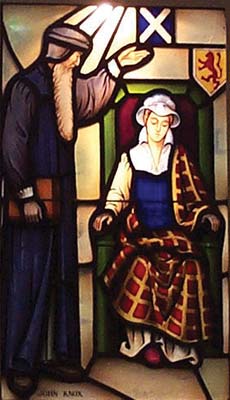
The Scots soon became disgusted with Mary’s messy personal life, starting with her 1565 remarriage. The groom was her first cousin, Lord Darnley—an English-Scottish prince whose claim to both crowns had made him many enemies. Their marriage soured, and rumors flew that Mary was getting fresh with her secretary. The secretary was brutally murdered at Edinburgh’s Palace of Holyroodhouse in front of a horrified Mary, and suspicion fell on Darnley. Then Darnley himself was found strangled in his Edinburgh home, while Mary fled the country with the prime suspect—the earl of Bothwell—soon to be Mary’s third husband. Amid all of the drama, Mary gave birth to a son—whether Darnley’s or the secretary’s, no one knows—who would grow up to be king of both Scotland and England.
Following an uprising in 1567, Mary was forced to abdicate in favor of her infant son, who became King James VI of Scotland. Raised a Protestant, James assumed official duties at age 17 (1584) and brought a tentative peace to religiously divided Scotland. (Meanwhile, Mary was arrested on suspicion of the murder of Darnley, charged with an unrelated plot against her cousin, Queen Elizabeth I of England, and eventually beheaded in 1587.)
In the 1592 Golden Act, Presbyterianism triumphed, and was made the rule of law. Scotland went forward as a predominantly Protestant nation. But even among Protestants, there were religious divisions. Scottish Protestants were Presbyterians, members of the newly reorganized Church (or “Kirk”) of Scotland. Presbyterianism (from the Greek word prebuteros, “elder”) championed a self-governing congregation with leaders they elected themselves. This was in stark contrast to historic Catholic and Church of England hierarchies, led by a bishop (from the Greek episkopos) appointed by the king. The religious divide had political implications: Naturally, monarchs wanted to retain the politically powerful right to appoint bishops and rule congregations, while Presbyterians insisted on separation of kirk and state. Presbyterians also tended to be anti-king and pro-parliament.
In 1603, Queen Elizabeth I—England’s “virgin queen”—died without an heir. Her distant cousin, Scotland’s King James VI, was next in line for the English throne. Upon leaving Edinburgh and being crowned England’s King James I in London (making him both King James VI and I), he united Scotland and England. The two nations have been tied together, however fitfully, ever since.
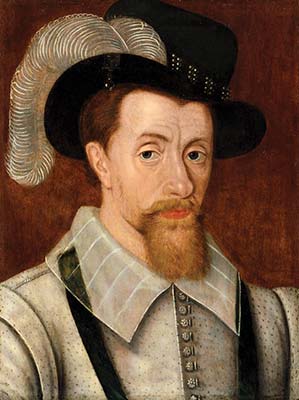
James’ son Charles I (1600-1649) was born and crowned in Scotland, but otherwise spent most of his life in England. He continued his father’s attempts to consolidate the many threads of Protestantism throughout his lands, favoring the English Episcopalian model. Charles I traveled to St. Giles’ Cathedral in Edinburgh; appointed a bishop who, in turn, anointed him; and eventually introduced his own prayer book. This was a bridge too far for the Scots, who rioted and signed the National Covenant, proclaiming that the Scots had a special relationship with God that was outside the control of the crown. These “Covenanters” effectively declared their independence from the Church of England, and insisted that the Church of Scotland was under entirely Scottish control. A revolution was brewing.
The Covenanters went on military raids into northern England. King Charles attempted to quell the uprising with promises of reform, but became distracted by problems closer to home: Civil war broke out in England, pitting Charles (and the monarchy and Anglicanism) against Oliver Cromwell (with his supporters in parliament and the Puritans). Scotland was also divided. The Covenanters backed Cromwell, while many traditional Highlanders backed the king.
A Scottish army of 25,000 Covenanters invaded England, captured Charles I, and turned him over to Cromwell. On January 30, 1649, the English beheaded the king of Scotland.
Left without a king, Scotland’s landed gentry crowned Charles’ son at Scone on January 1, 1651 (the last coronation at Scone). But Cromwell marched north and put a decisive end to any ideas of Scottish independence. It was clear that Scotland could never again be independent without the approval of England.
Charles II (1630-1685) escaped to France, where he spent the next nine years in exile. In 1660 he was invited back to London, and in 1661, the English parliament—suffering from Cromwell remorse—invited him to take the English throne. The monarchy was restored, with Charles II (a Stuart) ruling both England and Scotland.
But the two countries remained bitterly divided over religion. After Charles II died, his Catholic successor—James II (James VII of Scotland)—was ousted by England’s parliament in a coup d’état (called the Glorious Revolution), and replaced by a Protestant noble from the Dutch House of Orange-Nassau and his English wife (King William III and Mary II).
In Scotland, the newly ascendant Lowland Protestants set about forcing Highland Catholics and Episcopalians to swear allegiance to the Protestant king. This culminated in the infamous Glencoe Massacre of 1692, where pro-William Protestants of the Campbell clan used the occasion as a pretext to slaughter their centuries-old enemy, the MacDonalds. (For more on Glencoe, see here.)
At the same time as Scotland’s king was being forced into exile, the world was changing in other ways. England was on the rise as a naval and colonial superpower, and began encroaching on Scotland. Many Scots, particularly in the southern Lowlands, welcomed the English presence. These were people of Anglo-Saxon heritage, Calvinists and parliamentarians (who had like-minded counterparts in England), and traders and industrialists (who wanted to trade with wealthy England).
Due to a failed trading-post venture in Panama (the Darien Scheme), Scotland went bankrupt. Members of the Scottish parliament (some of whom were bribed) agreed to accept a bailout from England, which came with one major string attached: the Act of Union. So in 1707, Scotland’s parliament (dominated by wealthy Lowlanders) voted itself out of existence, and the Scottish nation was officially joined with England, becoming part of “Great Britain.” The independence of the Scottish nation—led by the Stuart family since the days of Robert the Bruce—was over.
Or was it? Many Scots, especially in the Highlands, clung loyally to their ousted King James II (VII of Scotland) and his successors. They were called Jacobites—after the Latin “Jacobus” for James—and saw the Stuarts as their best hope to regain Scotland’s independence. On the other side was the ascendant Protestant/urban faction, who supported the British government and monarch.
In the first of two Jacobite “risings,” a coalition of traditionalists, Highland clans, and Catholics rallied around James II’s son in 1715. But English troops easily routed them at the Battle of Sheriffmuir (10 miles north of Stirling), the grand hopes of “The ’15” rebellion sputtered, and James Junior was sent scurrying back to his home-in-exile in France.
In 1745, a second rebellion was led by James II’s grandson, known as “Bonnie Prince Charlie.” That summer, the exiled Prince Charles sailed across the sea from France and landed in Scotland near Glenfinnan (see here), where he raised an army of Highlanders and set out to re-establish the Stuart monarchy. The terrified king put a price on Charles’ bonnie head (the equivalent of £15 million today), but the outlaw prince succeeded in rallying many Scots to his cause. Within a few months, inspired by their charismatic leader, the Highlander forces had taken most of Scotland and even much of northern England. In their march toward London, they penetrated as far south as Derby—just 125 miles from the Tower of London. But the gains were ephemeral. Prince Charles’ army was small (6,000 men) and disorganized; promised French support failed to materialize; and he had almost no popular support in the Lowlands, much less in England.
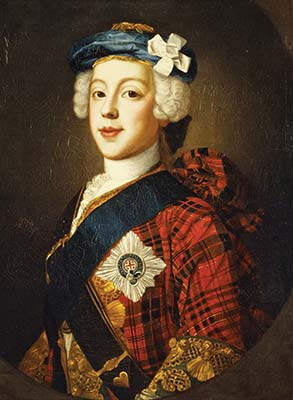
As better-equipped British troops advanced, Prince Charles pulled back to the Highlands. The two armies finally met in 1746 for one final, bloody conflict at Culloden Moor, just outside of Inverness, where Bonnie Prince Charlie’s ragtag, kilted, bagpipe-bolstered army was routed and massacred. (For more on the prince and his defeat, see here.) Charles himself escaped the chaos, dressed as a female servant to sail “over the sea to Skye,” and ultimately died in exile in Rome. To this day, patriotic Scots lament the crippling blow dealt to the rebellion they call “The ’45.”
After Charlie’s defeat, the authorities (aristocratic landowners with government assistance) came down brutally on those who had supported the Jacobites, targeting the Highland clans and their traditional way of life. Kilt-wearing was forbidden, the feudal clan system was dismantled, homes were burned, and valuables were plundered. Clan chieftains who hadn’t been exiled took over formerly communal lands and treated them as their own.
Landowners decided to make more efficient use of their land, bringing about the so-called “Highland Clearances” (which escalated following The ’45, and peaked in the early-19th century). They evicted their farming populations and transformed the agricultural model from croft (subsistence farming of locally used crops) to mass production (more profitable sheep). Many displaced farmers moved to cities for factory work (as this coincided with the burgeoning Industrial Revolution—see the next section). Many others sought a better life in the New World.
From the mid- to late-19th century, an estimated two million Scots emigrated, mostly to North America, Australia, and New Zealand. Many perished in the perilous four-month Atlantic crossing, on vessels so rife with disease they were nicknamed “coffin ships.” Those who survived employed their Scottish work ethic and industriousness to help build their adopted nations (concentrated in places like Nova Scotia—“New Scotland”). Some 15 percent of today’s Canadians cite Scottish heritage. In fact, the “Scottish” populations of both Canada and the United States rival the population of Scotland.
Meanwhile, back home, Highland culture all but died out. It was a bleak time for traditional life in Scotland.
Despite the difficult times in the Highlands, Lowlands Edinburgh thrived. In the last half of the 1700s, the city had become one of Europe’s (and the world’s) most intellectual cities. Edinburgh benefited from a rich university tradition, a strong Protestant work ethic, an educated middle class, connections with a powerful England, and, simply, good genes. Edinburgh was a city of secular, rational thinkers who embraced the scientific method and empirical observation.
Scots of note from this period include philosopher David Hume (who applied cool rationality and a scientific approach to religion, morals, and philosophy); economist Adam Smith (who wrote about division of labor and the free market in The Wealth of Nations); James Watt (who developed better steam engines, propelling Great Britain—and the world—into a busy Industrial Age); and great names in virtually every discipline: geologist James Hutton, chemist Joseph Black, painter Allan Ramsay, and of course the literary greats Robert Burns (see the sidebar) and Sir Walter Scott (see here). It’s fitting that the Encyclopedia Britannica—the pre-Wikipedia authority on all things—was first published in Edinburgh in 1768.
As the Industrial Revolution dawned, Scotland became a powerhouse: Textiles were woven in large factories, powered by Watt’s steam engine, which were fueled by Lanarkshire coal, then exported on iron ships built in the Clyde shipyards. Scotland was a global leader in pig iron exports and shipbuilding. Glasgow—an industrial center—overtook genteel Edinburgh as Scotland’s biggest city. Dundee boomed, thanks to its skill for processing jute, which could be turned into rope, sacks, sails, and other essential items for a seafaring culture (for more, visit Dundee’s interesting Jute Museum—see here).

In the early 19th century, the Scottish civil engineer Thomas Telford (1757-1834)—nicknamed “The Colossus of Roads”—designed roadways, bridges, canals, and locks to tie together the remotest corners of Scotland, effectively shrinking the country for the modern era. (His masterpiece, the Caledonian Canal, is easy to see between Fort William and Inverness—see here.)
Meanwhile, just a few decades after the harsh post-Jacobite crackdown, Highland culture began to enjoy a renaissance. By the late 18th century, people were already romanticizing Bonnie Prince Charlie (further spurred by Sir Walter Scott’s 1814 historical novel Waverley). In the Romantic Age of the 19th century, tartans, kilts, bagpipes, and other aspects of Highland culture made a big comeback. In 1852, Queen Victoria and Prince Albert purchased Balmoral Castle (in the shadow of the Highlands’ Cairngorm Mountains—see here), and proceeded to renovate it in a fanciful interpretation of the Scottish Baronial style. This signaled not just an acceptance, but a nostalgic embrace, of traditional Highland culture, just a century after it had been dismantled by the same monarchy.
This Scottish Baronial style, popularized by Sir Walter Scott, was a Romantic, Neo-Gothic celebration of medieval Highland castles. It features a stout sandstone structure with pointy turrets, fanciful finials, round towers, crenellated battlements, and narrow windows—based on Scotland’s 16th-century tower houses, which were in turn based on the châteaux of France. In many ways, this is Scotland’s signature architectural style: You’ll see it everywhere, from the urban streets of Glasgow, to castles on the remotest fringes of Scotland, to a fictional school for witchcraft and wizardry.
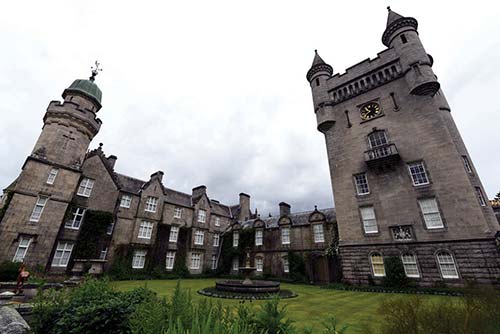
By the 20th century, Scotland was the workhorse of Great Britain. And as bastion of the working class, there’s little wonder that the government was typically controlled by the Labour Party. James Ramsay MacDonald was PM of the UK from 1929 until 1935.
Scotland was also the workhorse of the British military—never more so than during World War I, when Scottish lads were disproportionately massacred on the battlefields of Europe. Scotland, with about one-tenth of the UK’s population, had double the per-capita deaths of other parts of Britain. One out of every four Scottish soldiers never came home. Earl Haig of Edinburgh commanded British troops—victoriously—through some of the most gruesome trench warfare in history, at Flanders Fields in Belgium. As you travel around Scotland, you’ll find a WWI memorial in every tiny village—with unsettlingly long lists of local boys who sacrificed the utmost for Britain.
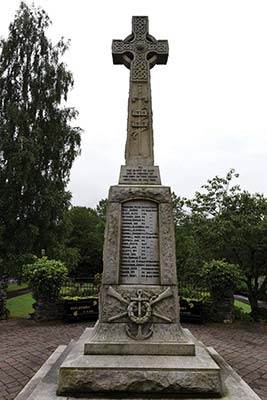
On most of these memorials, you’ll find a little “addendum” plaque listing WWII deaths. While the Blitz was devastating to London and other English towns closer to the Continent (such as Coventry), the impact of World War II was felt less in the far-north reaches of Scotland—though Scapa Flow, a natural harbor surrounded by the Orkney Islands, was the remote headquarters of the British navy in both World Wars (see here).
By the last decades of the 20th century, change was percolating in Scotland. Since the 1980s, the main topic of Scottish political debate has become “devolution”: the push to “devolve” authority over Scottish affairs from London to Scotland proper. The general sea change in European culture over the last few generations of respecting smaller, underdog nations—even at the expense of big, historically dominant countries—has been felt here as much as anywhere.
For centuries—essentially ever since the crushed Jacobite uprisings—the notion of Scottish independence was rarely taken seriously. That began to change in the mid- to late-20th century. The independence-minded Scottish National Party (SNP), which had been founded as a fringe movement in 1934, won its first seat in the UK parliament in 1967. The discovery of North Sea oil in the late 1960s gave this often-overlooked corner of the United Kingdom some serious economic clout, and with it, more political pull. Pro-independence factions gained traction with the slogan “It’s Scotland’s oil,” proposing a windfall for Scots suffering through post-industrial rot and economic malaise.
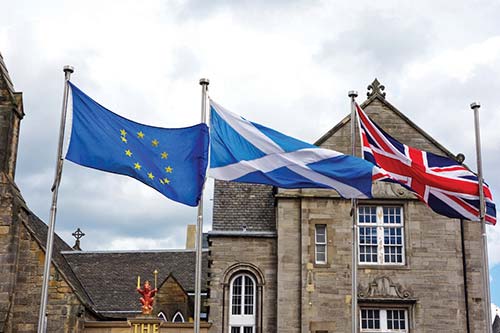
The SNP gained seats in the UK parliament and pushed for a 1979 referendum on devolution. The measure won with 52 percent of the vote, but turnout was too low to legitimize the result. Through the 1980s and most of the 1990s, anti-independence UK prime ministers Margaret Thatcher and John Major downplayed devolution talk. But the SNP and other agitators ensured that the idea never completely faded.
When Prime Minister Tony Blair took office in May 1997, his Labour government (mindful of Scotland’s strong working-class roots and long-standing support for the Labour Party) was more open to the idea of devolution. And in a referendum in September 1997, three out of every four Scots voted “yes” to the statement, “I agree that there should be a Scottish parliament.” In response, the UK parliament passed the Scotland Act 1998, creating a Scottish parliament that convened to much fanfare in Edinburgh on May 12, 1999 (with Donald Dewar becoming the first-ever First Minister of Scotland). For the first time since the Act of Union in 1707, Scotland had its own parliament. The Scottish Parliament building—with mind-bending architecture and an inviting garden—opened in 2004 across the street from the Queen’s residence at the Palace of Holyroodhouse (it’s free to tour the interior—see here).
With devolution, Edinburgh once again has become the actual self-governing capital of Scotland. The Scotland Act 2012 further expanded the mandate of the Scottish parliament, and today, the list of “devolved” issues (under local Scottish control) includes education, the environment, health and social services, housing, and tourism. Other matters—including foreign policy, defense, energy policy, and social security—remain “reserved” for the central UK government.
Today the SNP is the most powerful party in Scotland (controlling 63 out of 129 seats in the Scottish parliament), and the third-largest party in the UK (controlling 35 out of 650 seats in the UK’s House of Commons; there are only 59 House of Commons seats for Scotland). Its leader, Nicola Sturgeon of Glasgow, is the public face of the SNP, giving voice to independence-minded Scots.
Today’s supporters of Scottish independence take up ballots, not broadswords. On September 18, 2014, the Scottish people went to the polls to vote on a simple question: “Should Scotland be an independent country?” Right up until the day of the referendum, many observers believed that Scotland was about to declare its independence, which would have opened up a whole range of questions about how two prosperous and powerful countries could peacefully disentangle themselves. But the results were clear: 55.3 percent of Scottish residents voted “no.” While Scotland will remain part of the United Kingdom—for now—the referendum signaled to many in the greater UK that Scotland must be taken seriously. During the campaign, the opposition promised Scotland even more political autonomy if it voted “no.” While Scottish nationalists want to fast-track these new powers, it’s not clear how quickly it will happen. One thing is sure: The vote may be over, but the nationalists aren’t done fighting yet.
In 2016, Britain voted to “Brexit” or leave the European Union. Most Scots voted to remain with the EU. Adding a new twist to the complicated political situation, it’s likely that pro-EU Scotland would have voted for independence in 2014 had they known that the UK would vote to take them out of the EU two years later. Now, as the UK sorts out its messy situation with the EU, England’s restless Celtic partners are wondering where their best future lies. And, at this point, nobody knows.
Throughout Scotland’s history, the country has been a center of both scientific and creative thought. The 18th-century age of Scottish Enlightenment in particular was a hotbed of intellectual progress—I’ve listed the greats of that era earlier in this chapter (on here).
Famous artistic Scots include royal portraitist Henry Raeburn (whose 1790s ice-skating minister, The Reverend Robert Walker Skating on Duddingston Loch, still adorns modern-day Christmas cards); 20th-century landscape painter William MacTaggart; and Scotland’s greatest architect Charles Rennie Mackintosh (see sidebar on here).
Scottish entertainers are everywhere, from the original James Bond (Sean Connery) and the young Obi-Wan Kenobi (Ewan McGregor), to two Dr. Whos (David Tennant and Peter Capaldi). Actors James McAvoy, Gerard Butler, Karen Gillan, Tilda Swinton, Billy Connolly, Craig Ferguson, Robert Carlyle, Robbie Coltrane, and Alan Cumming all hail from Scotland, as do musical artists the Proclaimers, Annie Lennox, Cocteau Twins, the Jesus and Mary Chain, Belle and Sebastian, and Franz Ferdinand; and sports stars Andy Murray (tennis), Catriona Matthews (golfer), and Jackie Stewart (auto racing). Scotland’s literary tradition is particularly strong (see sidebar on here), with writers from Robert Burns to Sherlock Holmes creator Sir Arthur Conan Doyle making the country proud.
On the scientific front, Peter Higgs was researching at the University of Edinburgh in the 1960s when he speculated on the existence of a subatomic “God particle” that might tie together many other theories on the structure of the universe.
Great people of Scottish descent fill American and Canadian history books, among them James Monroe, Washington Irving, Andrew Carnegie, Alexander Graham Bell, Jack Daniel, Ronald Reagan, Neil Armstrong, and Bill Gates. Whether it’s as part of the United Kingdom, or as its own increasingly independent nation, it’s clear that Scotland’s impact on the world has only just begun.